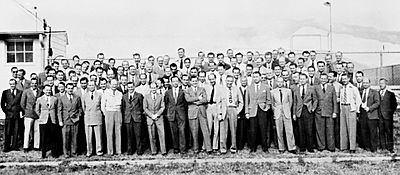Bernhard Tessmann facts for kids
Bernhard Robert Tessmann (born August 15, 1912, died December 19, 1998) was a German expert in guided missiles during World War II. After the war, he worked for the United States Army and later for NASA. He played a key role in developing rockets that helped with space travel.
A Young Rocket Expert
Bernhard Tessmann first met the famous rocket scientist Wernher von Braun in 1935. Even though his father worked at a film studio, and he saw movie sets about space, Tessmann wasn't very interested in space travel at first.
He helped with the early plans for the Army Research Center Peenemünde in Germany. He moved there in late 1936. His job was to oversee building the test sites and to conduct the first engine tests. Tessmann worked on special wind tunnels and systems to measure the power of V-2 rocket engines.
Protecting Rocket Secrets
In August 1943, after a bombing, Tessmann was moved to Koelpinsee. There, he designed ground equipment for mobile V-2 rocket units. He also helped plan secret underground V-2 facilities in Austria and test sites near Lehesten.
Towards the end of World War II, Tessmann became very important for saving valuable rocket information. Wernher von Braun was worried that German authorities might destroy all the important V-2 documents and blueprints. So, he asked his assistant, Dieter Huzel, and Bernhard Tessmann to hide these papers in a safe place.
They used three large trucks to carry about 14 tons of documents. On April 3, 1945, the small group headed north into the Harz Mountains. Tessmann and Huzel found an old iron mine in a quiet village called Dornten. Within 36 hours, all the documents were moved deep inside the mine and hidden in a powder storage room.
Moving to America
Soon after, von Braun and his top rocket scientists, including Tessmann, gave themselves up to the U.S. Army. The hidden 14 tons of V-2 documents were also found. This information was very important for future rocket development.
Tessmann moved to the United States after the war. This was part of a special program called Operation Paperclip, which brought German scientists to the US. By January 1947, he was working at Fort Bliss in Texas. He continued to work with the rocket team for the rest of his career. He worked at Fort Bliss, then at White Sands Missile Range, and later in Huntsville, Alabama.
By 1960, he was a Deputy Director of the Test Division at NASA's Marshall Space Flight Center. He passed away in Huntsville, Alabama. Today, the Ilse and Bernhard Tessmann Music and Foreign Language Scholarship is awarded at the University of Alabama, Huntsville.


